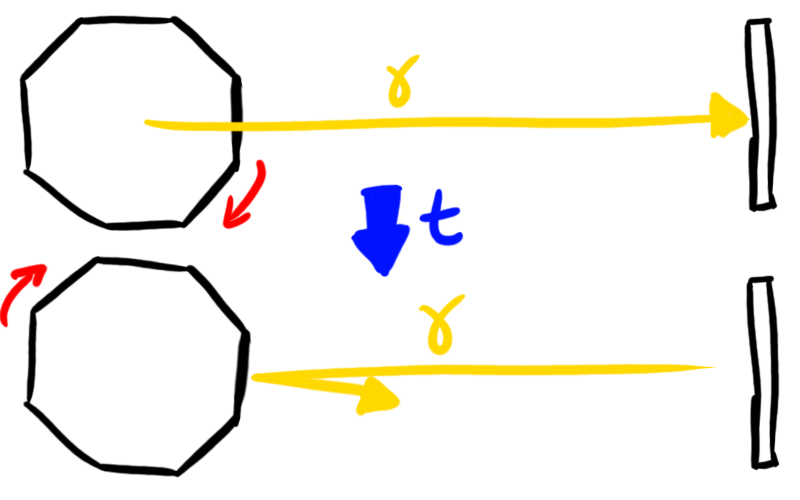 Some Light Reading
Some Light Reading
Light is maybe one of the more important things in the universe (though this is debateable—some sensible people rank chocolate above it). It also has a rich history of people not really knowing what it was, how fast it moves, or even how it moves. So, in order to better understand it, let's turn back time, and cover a bit of light history (these puns never get old).
For a very long time, people believed light to be instantaneous, and for good reason. When is the last time you could see light move from place to place? Some folks disagreed, including a man born on February 15th in 1564 by the name of Galileo Galilei. Galileo attempted to measure the speed of light much like one might measure the speed of sound. In fact, you and another person could get a rudimentary measurement of the speed of sound using this method, so let's cover the sound applications first:
You stand on a hill somewhere (hill optional, but it makes for a better visual) with a stopwatch, and have a friend stand on another hill within sight of you (but decently far away). Make sure you know the distance between you two as precisely as possible. Now, shout (or use an air horn, or make a loud noise somehow), and simultaneously start your stopwatch. As soon as your friend hears you, he or she should shout (air horn/loud noise) right back at you. As soon as you hear your friend's shout (air horn... etc.), stop the stopwatch. Now, using the simple formula that distance = rate * time, and knowing distance between you and time, you can plug in (distance between you * 2) / (time on the stopwatch) = speed of sound. Pretty neat, easy experiment. Galileo tried the same thing, but using lanterns (uncovering them when they saw the light), and tried to deduce the speed of light. However, he could only conclude that the speed of light was "if not instantaneous it is extraordinarily rapid." It wasn't until much later, in 1862, that another experiment was conducted which could more accurately deduce the speed of light.
In the meantime, it wasn't like people weren't trying. Two attempts at calculating the speed of light using astronomy in the late seventeenth and early eighteenth centuries did give speeds which grew closer to the current measurement: Ole Roemer observed apparent differences the the speed of the orbits of Jupiter's moons depending on the distance from Earth, and calculated the speed of light to be around 200,000,000 m/s. 53 years later James Bradley used stellar aberration (the apparent difference in stellar motion due to the Earth's orbit) to deduce the speed of light to be 301,000,000 m/s. Finally, a physicist by the name of Leon Foucault devised a method using a beam of light and a rotating mirror. The beam of light was emitted at a mirror, which reflected it back to a set of rotating mirrors in the shape of an octagon. Because the rotating mirror(s) started perpendicular to the beam of light, but had some degree of motion (the remote stationary reflecting mirror was rather far away), the light would reflect off of it at an angle.

Measuring the degree of reflection from the normal, and knowing the distance between the two mirrors (rotating and stationary), and the speed of rotation, he could calculate the speed of light. His number, in 1862: 299,796,000 m/s. For reference, further experimentation and rigorous study has pegged the speed of light at 299,792,458 m/s as of present day.
So what, exactly, is light? Well, that's a complicated question. Let me answer first by saying it's a wave (we'll get to duality later). We can easily see that it is with the classic double-slit experiment, in which we shine a beam of light at a board with two narrow slits parallel to each other, and see a diffraction pattern emerge on the wall behind them. Much the same way the beam of your flashlight spreads out from the bulb, it spreads out again after passing through the slits, and the two "beams" interfere with each other as waves are wont to do. You can see this behavior in any classical waves—do the double-slit experiment in your bathtub (with wider slits to accommodate for the water waves, and make sure they go to the surface, after all, that's what's visibly waving) and see the same diffraction pattern emerge on the other side as the waves join back up. So, we know light is a wave. But, if it were to be a wave, what exactly is waving, so to speak? After all, all waves have a medium: the waves in the ocean move through the water—the water is waving there. Sound waves move through whatever medium they can, and the lack of any sort of matter medium in space (you know, that "vacuum" thing) keep anyone from hearing you scream. But we definitely know that waves travel through space—after all, they travel the 93 million or so miles from our sun to our planet through that wonderful emptiness. So, for a long time (until the early twentieth century) many physicists believed that space was pervaded with the so-called "luminiferous aether," the medium which "waved" for light.
But the luminiferous aether had some problems, namely that it couldn't be observed, and also, as the Michelson-Morley Experiment demonstrated, Earth's speed through it had no effect on the speed of light. See, since Earth is orbiting the sun, there are any number of two distinct points in the year where it will be travelling precisely opposite directions through space. Now, if space was pervaded by this luminiferous aether, the Earth's different relative motion through space (and the aether) should affect the speed of light. But, it didn't. For a short time, some physicists tried to argue the idea of "aether drag," wherein the luminiferous aether around the Earth was dragged with it somehow, but it was abandoned when Einstein's theory of relativity came out and explained everything without the need for a mysterious aether.
Still, if it wasn't the luminiferous aether that was/is waving, than what substance was/is it? Well, it's not a substance at all. You've probably heard light described as an electromagnetic wave (EM wave for short), or at least heard of the EM spectrum. Well, that means that light is composed of two alternatively waving fields: electric and magnetic. Every moving electric field creates a magnetic field—that's how solenoids or electromagnets work: when you run current through the coil of wire, you create a moving electric field (from, you know, the electricity). So, perpendicular to that field, you get a magnetic field. Well, a moving magnetic field also generates a perpendicular magnetic field. So, if you imagine (or look below this paragraph at the image) two waves, one describing a magnetic field, and one describing an electric field, both overlapping each other and each one pushing the other one on, you get the idea. In fact, as determined by physicist James Clerk Maxwell, the speed at which this electromagnetic wave would propagate would be around 299,792,458 m/s—or, you know, the speed of light.

But wait! You may have heard that light is also a particle. Physicists often describe light in "photons," as well as waveforms, and, as the old joke goes, if you ask a physicist whether light is a partile or a wave, they'll reply "yes." See, in certain experiments, light behaves in a manner that more fits a particle than a wave (such as in the photoelectric effect). Light, as it turns out, can be measured as either a particle or a wave—and works for both. Light suffers from the same problem it turns out most things seem to in physics: wave-particle duality. But that topic is for another time, as I've gone on quite long enough about this material, even though it's only been a few light facts.
...I'll see myself out.
